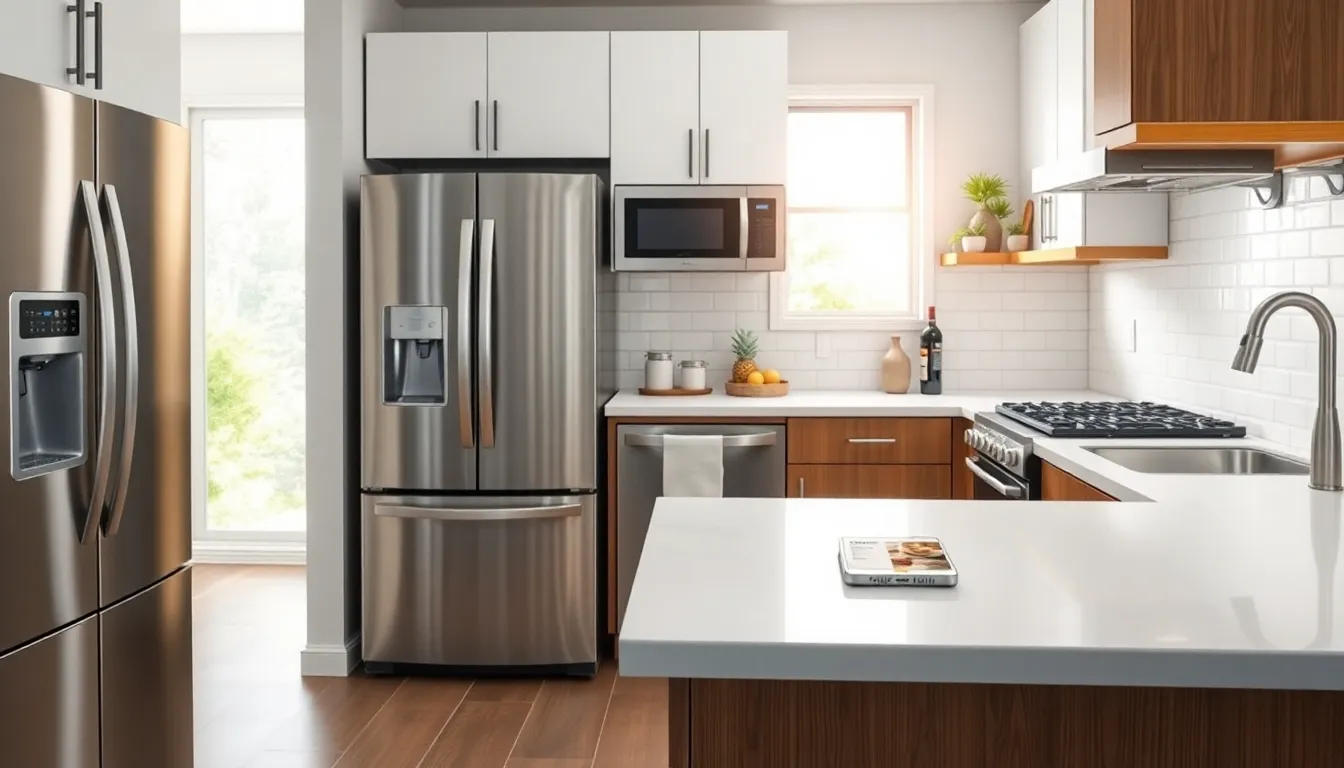In the land of sunshine and palm trees, California’s energy landscape is evolving faster than a surfer catching a wave. Enter the era of energy-smart homes, where technology meets sustainability, making it easier than ever to save the planet while keeping the electric bill from soaring higher than a hot air balloon.
Imagine living in a home that not only remembers your coffee preferences but also knows when to dim the lights to save energy—talk about a smart house! With innovative gadgets and eco-friendly solutions, Californians are embracing a lifestyle that’s as green as their favorite avocado toast. From solar panels to smart thermostats, these homes are designed to be efficient, stylish, and just a little bit sassy. So, let’s dive into the world of California energy smart homes and discover how they’re changing the game for homeowners and the environment alike.
Table of Contents
ToggleOverview of California Energy Smart Homes
California’s energy smart homes represent an innovative step toward sustainable living. These residences leverage advanced technologies, including solar panels, energy-efficient appliances, and smart thermostats, to reduce energy consumption. Such homes often feature home automation systems that synchronize various devices, optimizing overall energy use.
Residents benefit from significant savings on electricity bills, while also contributing to reduced carbon footprints. Energy management software tracks usage patterns, enabling homeowners to identify and rectify wasteful practices. Enhanced insulation and strategic design further promote energy efficiency, shielding homes from extreme temperatures.
California’s commitment to renewable energy reflects a broader trend toward eco-friendly living. The state incentivizes the adoption of energy-smart features through rebates and tax credits, making them accessible to more citizens. Increasing awareness around climate change drives demand for sustainable home upgrades.
Technicians often install energy monitoring systems that provide real-time feedback on energy consumption. Homeowners can adjust their behavior based on this data, fostering a culture of energy awareness. Innovative building designs, such as passive solar architecture, utilize sunlight for natural heating and lighting.
Integrating electric vehicle charging stations into these homes supports the growing shift toward electric cars, enhancing overall energy synergy. Smart homes present opportunities for community engagement, where neighbors can share energy-saving tips and collaborate on renewable initiatives. This model prepares residents for a future where energy efficiency increasingly influences property value and lifestyle choices.
Key Features of Energy Smart Homes


Energy smart homes incorporate advanced technology to maximize energy efficiency. These features contribute to sustainable living and significant cost savings.
Smart Appliances
Smart appliances represent a cornerstone of energy efficiency in modern homes. Energy-efficient refrigerators, dishwashers, and washing machines automatically adjust their settings based on usage patterns. These appliances utilize sensors to optimize energy consumption, reducing waste while maintaining performance. For example, smart thermostats learn household schedules and adapt climate control accordingly. This level of automation can lead to energy savings of up to 20%. Many manufacturers offer energy-efficient models with the Energy Star label, making it easier for homeowners to choose environmentally friendly options.
Home Automation Systems
Home automation systems enhance overall energy management in smart homes. These systems allow residents to control lighting, heating, and cooling remotely through smartphones or tablets. By using timers or motion sensors, homeowners can minimize energy use when rooms are unoccupied. In fact, studies show that automated lighting can cut down electricity costs by around 10%. Integration with smart devices enables seamless communication between appliances, ensuring optimal performance. With the rise of Internet of Things (IoT) technology, the potential for energy management grows, making homes smarter and more efficient.
Benefits of California Energy Smart Homes
California energy smart homes offer multiple advantages that improve both the household experience and environmental impact. These benefits include energy efficiency and cost savings.
Energy Efficiency
Energy efficiency ranks as a primary benefit of energy smart homes. Advanced technologies, like smart appliances and home automation systems, enhance energy management. Smart refrigerators and washing machines adjust settings based on usage patterns, leading to energy consumption reductions of up to 20%. Home automation systems enable residents to control lighting and thermostats remotely, leading to optimized energy use. Real-time energy monitoring provides feedback, fostering a stronger awareness of consumption habits. As energy bills decrease, households in California contribute less to carbon emissions, promoting a more sustainable lifestyle.
Cost Savings
Cost savings represent another significant advantage of California energy smart homes. By using energy-efficient appliances and smart technologies, households can cut electricity costs by around 10%. Installing solar panels often results in substantial long-term savings on utility bills, as homeowners harness renewable energy. State incentives, such as rebates and tax credits, further lower upfront costs, encouraging more homeowners to adopt these sustainable features. Additionally, reducing energy consumption lessens dependency on external energy sources, safeguarding against fluctuating energy prices.
Government Incentives and Programs
California offers several incentives to promote energy smart homes. Rebates for solar panel installations can reach up to $1,000, significantly reducing initial expenses. Programs through the California Public Utilities Commission encourage energy efficiency, often covering a part of the cost for upgrading appliances.
Tax credits for energy-efficient home improvements also exist. These credits help offset expenses related to installing smart thermostats or advanced heating and cooling systems. The state’s HERO program allows financing for renewable energy upgrades, enabling homeowners to pay through property taxes.
Funding opportunities are available for electric vehicle charging stations. Proposition 39 provides additional funding for energy efficiency upgrades in schools, indirectly supporting local home environments. Many utility companies also provide incentives for demand response programs, prompting homeowners to reduce energy usage during peak hours.
Homeowners may apply for assistance through the Single Family Housing Direct Home Loans or HUD programs, which offer support for energy-efficient home renovations. Educational workshops, often funded by state programs, teach residents about energy conservation techniques and benefits.
Such initiatives lead to greater energy awareness among Californians. Authorities encourage participation by highlighting potential savings on monthly utility bills. Engaging the community with these programs fosters a culture focused on sustainability and shared responsibility for the environment. Overall, these government incentives and programs play a crucial role in enhancing the adoption of energy smart homes throughout California.



